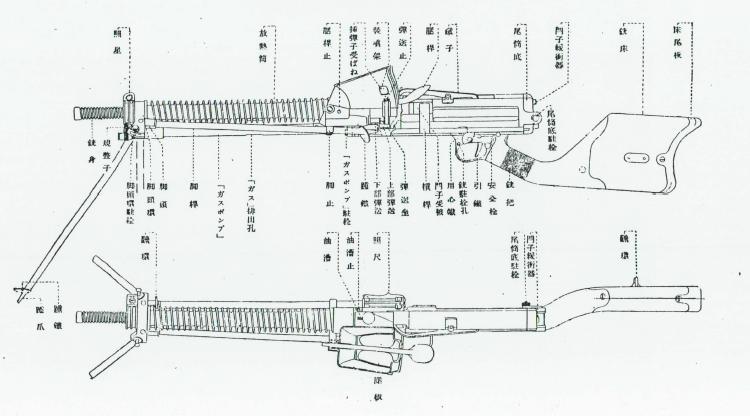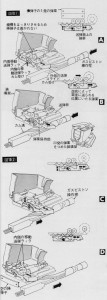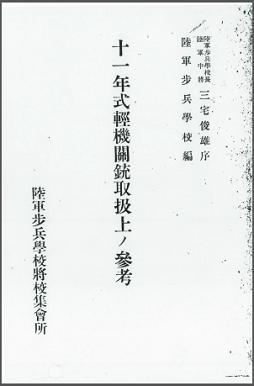Kojiro Nambu, one of Japan’s most prolific arms designers, developed the Type 11 light machine gun as an adaptation of his previous Type 3 HMG design. The Type 11 uses a distinctive hopper feed, and is a better gun than generally believed. Adopted by the Imperial Japanese Army in 1922, it remained in production until 1941.

The Type 11 uses a long stroke gas piston for operation, and the action uses a falling block to lock the bolt for firing. Angled camming projections in the sides of the receiver slide the locking piece down to lock and up to open when the bolt cycles. The bolt moves linearly back and forth with no special early leverage to aid extraction – a type of design which often has difficulties in field conditions. To ameliorate this potential problem, the Type 11 has an automatic oiler system to lubricate the cartridges prior to chambering. While fine in normal range conditions, oiled cartridges tend to attract dust and dirt, leading to another source of jamming problems on the battlefield.
The trigger mechanism of the Type 11 was a simple one, and the gun fired in full-automatic only from an open bolt.
The most unique element of the Type 11 is its hopper feed system. The gun is fed by standard 5-round stripper clips that were used by riflemen (specifically the, 6.5x50mm cartridges used by the Type 38 bolt action rifle). A hopper on the left side of the receiver held six clips, and had series of mechanical teeth activated by a cam track on the gas piston to pull cartridges off each clip and into the action. When the fifth round was fed, the clip would fall empty out the bottom of the hopper and the next full clip would drop into place for feeding. A spring loaded follower held pressure on top of the clips in the hopper, which could be refilled constantly during firing. You can see a diagram here of the feed mechanism (click to enlarge):

The hopper on the receiver also necessitated the sights being offset to the right of the bore. To compensate for this, the buttstock is also dog-legged off to the right of the gun. This is not always clear in photographs, but very obvious when handling the gun.
In theory, the hopper system shows a number of benefits. It offers easy logistics by allowing the riflemen and machine gunners to use identical ammunition supplies, and in theory allows the gun to fire indefinitely without breaks for changing magazines. In practice, however, the system required two men to run efficiently, and could not be easily reloaded on the move. A tripod was produced for use with the Type 11 as well, but appears to have been rare in actual use. Being fed from 5-round clips and without a quick-change barrel, the Type 11 was not really suited for sustained fire.
Captured Type 11 Nambus garnered some interest in Russian military circles in the 1930s, and an experimental variant of the DP28 light machine gun was manufactured using the same hopper feed system. We have several photographs of this gun over on the Kubynov LMG page. The Russians readily saw the inherent problems of the idea, and it never progressed past prototype stage.
There are also some long-lived misconceptions surrounding the Type 11. It is often written that the gun was unreliable and required a reduced-pressure cartridge to function. This is based on a grain of truth, but misunderstood. The Type 11, when clean, is a very smooth and pleasant gun to shoot and quite reliable. It also is designed with an adjustable gas regular to allow the use of a variety of ammunition pressure. However, it was determined that the relatively short barrel (17.5 inches) produced excessive flash with standard ammunition (initially intended for Type 38 rifles with barrel more than a foot longer). A new loading was introduced for this reason, which had a slightly lower muzzle velocity (under 100fps), but burned much more completely in the Type 11 short barrel and produced much less flash as a result.
Video:
Manuals:


In his work on Merrill’s Marauders and WWII ordnance in general, “Shots Fired in Anger”, I recall that Col. John George had generally favorable comments about the Type 11.
The Type 11 is one of those typically eccentric looking Japanese automatic weapons. It looks like something out of an Edgar Rice Burroughs “Mars” novel, and were there more surviving specimens, it might have made an excellent representation of a “radium rifle” in the recent film.
one unusual feature of this gun not mentioned in the article, is the spike type bayonet (similar to that of the FG42) mounted under the barrel. The Japanese military doctrine of the day put a strong emphasis on bayonet proficiency and as a result, almost all Japanese long arms from the period were capable of mounting a bayonet.
John George (in the HIGHLY recommended “Shots Fired In Anger”) seems to say the Type 11 only fired in full auto five round bursts although also saying that trait to be largely ideal in a situation where every round was to be packed in one someone’s back. Is this true, anyone?
George also notes, by the way, that the type 11 was not equipped with a bayonet stud, nor a carrying handle..
Radium Rifle? You betcha fer sure on that, though, along with the type 96 and the type 99.
As far as I know, there was no burst limiter on the Type 11 – although once it got dirty poor reliability may have effectively limited it to short bursts.
it is actually due to the feeding mechanism: the hopper is loaded w/ 5-round clips so each time a clip is empted thete was a short delay between the old clip falling out and a fresh clip engaging in the grooves causing the five round burst impression
Good information, David —- thanks!
it is actually due to the feeding mechanism: the hopper is loaded w/ 5-round clips so each time a clip is empted there was a short delay between the old clip falling out and a fresh clip engaging in the grooves causing the five round burst impression
Was the 11NambuLMG being used by the Chinese communist in 1946/47
Not that i could prove it, but some were probably captured from the japs then reused by the chinese, who during that time used anything they could get their hands on
‘Twould seem the Chicom lot was using anything they could get their hands upon including supposedly, lend-lease Thompsons.
Thank you for this great website.
Really love the japanese manual.
Ian, thanks for yet another outstanding presentation. IMHO, this one is probably the most interesting one yet. I can see where the myth about the Type 11 needing a reduced-charge cartridge to function reliably came from — a lot of authoritative publications simply say that the weapon used a reduced-charge cartridge, but don’t explain why, so many readers would naturally assume that this meant the weapon could not handle a standard full-powered round.
My understanding is that a lot of the bad info originally came from a couple US Army documents, which have been taken as gospel ever since the 1940s.
John George mentions in “Shots Fired In Anger,” relates the captured Type 97 20mm anti-tank rifle was great fun at their Beachcomber’s club until they ran out of ammunition. (Type 97; Think a 150 pound Bren gun.)
But he also notes after firing 50 rounds semi-automatically, it never doubled and had to (much later)read the official tech manual on it to discover it was full-auto…with apparently a very slow rate of cycle. Sometimes the Tech Manual is right. (or maybe rightish.)
My Dad once commented that there had been one, still in place on Attu when he participated in the retaking of Alaska’s Aleution Islands. He said, the rather sad part was the crew was armed only with the 20mm. No carbines, or even side arms, not even a bayonet. In other words, marginally able to resist a Sherman but basically defenseless against infantry. How would you like to be in that position?
Dad also noted that it was positioned in such a way as to give the landing craft a great deal of trouble, but it never fired a shot.
I have recently discovered a small (17″ by 3″) wooden box believed to be brought home from the Pacific during WWII by my wife’s grandfather. It contains 5 firing pins, 5 extractors, 2 recoil springs and some shims and other misc parts believed to be replacement parts for a Japanese weapon. I have been trying to find pictures or drawings to figure out what model weapon they are for.